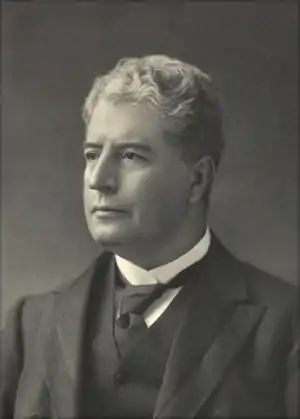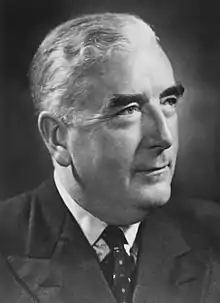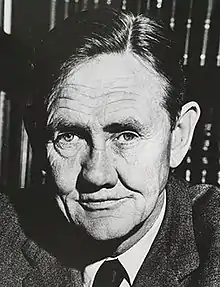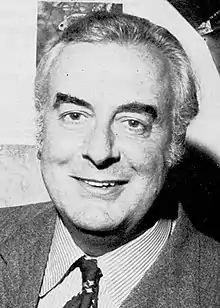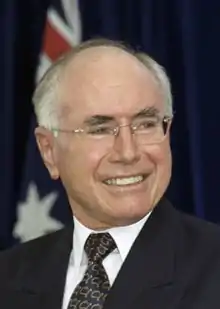English Australians
English Australians, also known as Australians of English descent or Anglo-Australians,[2] are Australians whose ancestry originates wholly or partly in England. In the most recent 2016 census, 7.8 million or 36.1% of respondents identified as "English" or a combination including English and is the largest 'ancestry' self-identity in the Australian census.[1] English Australians have more often come from the South than the North of England.[3]
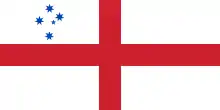 | |
| Total population | |
|---|---|
36.1% of Australia’s population | |
| Languages | |
| Australian English | |
| Religion | |
| |
| Related ethnic groups | |
| English diaspora, European Australians |
People of ethnic English origin and immigrants have been the largest group to migrate to Australia since the establishment of the Crown colony of New South Wales in 1788.[4]
History
1788–1900

Sydney was founded by the British government as a penal colony. Visitors described the English character of Sydney for at least the first 50 years after 1788, noting the traditional English appearance of the churches overlooking the convict barracks. First-generation colonial Sydney residents were predominantly English. 160,000 convicts came to Australia between 1788 and 1850.[6] Between 1788 and 1840, 80,000 English convicts were transported to New South Wales, with the greatest numbers coming between 1825 and 1835. The New South Wales Census of 1846 accounted for 57,349 born in England, 47,547 born in Ireland and 14,406 born in Scotland.[7]
| English settlers 1846-1891 | ||||
|---|---|---|---|---|
| Year | Population | Ref(s) | ||
| 1851 | 51,122 | [8] | ||
| 1861 | 84,152 | [8] | ||
| 1871 | 87,334 | [8] | ||
| 1881 | 107,574 | [8] | ||
| 1891 | 149,232 | [8] | ||
| Source: The NSW census | ||||
Until 1859, 2.2 million (73%) of the free settlers who immigrated were British.[9]
Many more English people immigrated to Victoria by the gold rush of the 1850s. By 1854 there were 97,943 England-born people in Victoria. Immigration policies and assistance schemes helped maintain high levels of immigration from England. Of the 1 million immigrants who arrived between 1860 and 1900, just over half came from England.[10]
When transportation ended, convicts made up 40 percent of Australia's English-speaking population.[11] Between 1840 and 1870 there were more Irish than English assisted migrants which did not change until the 1870s, when there were more English.[7]
At least 75 per cent of all overseas-born people in Australia during the 19th century were from the British Isles. The proportion who had been born in England or Wales remained quite stable (at about 47 per cent) from 1861 to 1911, as did the proportion born in Scotland (about 12 per cent).[12]
Federation: 1901–present
Australians born in England or of English ancestry made up more than 50 percent of the population at the time of Federation (1901).[13] From 1922 the Empire Settlement Act assisted thousands of migrants from England. After the Second World War, even as immigration from other countries expanded dramatically, English citizens had almost unrestricted entry into Australia. Arthur Calwell, Minister for Immigration, wanted nine out of ten new immigrants to be UK-born.[10] The majority of England-born migrants received assisted passages until the scheme was abolished in 1982. In 2006 the English were still the largest group of overseas-born in Victoria, with over 3% of Victorians born in England.[10]
| English-born population 1911–present | |||
|---|---|---|---|
| Year | Population | Ref(s) | |
| 1911 | 346,030 | [14] | |
| 1921 | 446,124 | [15] | |
| 1933 | 486,831 | [16] | |
| 1947 | 381,592 | [17] | |
| 1954 | 478,411 | [18] | |
| 1961 | 556,478 | [18] | |
| 1966 | 681,526 | [18] | |
| 1971 | 842,032 | [19] | |
| 1976 | 874,055 | [20] | |
| 1981 | 889,124 | [21] | |
| 1986 | 880,890 | [22] | |
| 1991 | 896,336 | [23][24] | |
| 2001 | 847,365 | [25] | |
| 2006 | 856,940 | [26] | |
| 2011 | 911,592 | [26] | |
Among the notable English-born were politicians such as Henry Parkes, and Joseph Cook; in retailing and media: John Norton, Anthony Hordern and John Fairfax.[7]
Surges of English immigration in the 1880s, between 1910 and 1914, again in the 1920s and, most of all, in the 1950s and 1960s, sustained the English-born as the largest single immigrant group.[7] In 1978 Australians born in England or Australians of predominantly English ancestry made up over 45 per cent of the population.[27] English ancestry was reported by 6.6 million people (46%) in 1986, and 6.4 million (37%) in 2001.[28]
The English continue to be well-represented among immigrants to Australia, the overall decline of English immigration to Australia since the 1980s has meant that the England-born component of the population as a whole is falling. With over 200 years of English settlement, however, Australian society continues to be influenced by its strong English heritage.[4]
Census
In the 2016 census form, people were asked 'What is the person's ancestry?’.[29]
| Declared ancestry 1986–2016 | ||||
|---|---|---|---|---|
| Year | Population |
% of population | % change | Ref(s) |
| 1986 | 6,607,228 | 42.3% | [30] | |
| 2001 | 6,358,880 | 33.9% | [31][32] | |
| 2006 | 6,283,647 | 31.6% | [33] | |
| 2011 | 7,238,533 | 33.7% | [34][35] | |
| 2016 | 7,852,224 | 36.1% | [1] | |
Cultural influence

People of English descent were by far the single most influential ethnic group in colonial Australia.[36] The founding of Australia by English people is still evident in place names, buildings and street layouts, and that 80 percent of the population speak English as their mother tongue and the Low Church hegemony in the Anglican Diocese of Sydney, the biggest in the country.
In Sydney, at least 50 suburban names are derived directly from 20 English counties, of which the largest numbers are from Kent, Surrey and London. Among the best known are Surry Hills, Croydon, Hornsby, Epping, Chipping Norton, Brighton-le-Sands, Bexley, Canterbury, Ryde, Kensington, Lewisham and Penshurst.[2]
Notable people
English convicts transported to Australia
- James Blackburn – known for contributions to Australian architecture and civil engineering
- William Bland – naval surgeon transported for killing a man in a duel; prospered and was involved in philanthropy; had a seat in the legislative assembly[37]
- William Buckley – escaped and lived with Aboriginal people for many years
- John Cadman – had been a publican; as a convict became Superintendent of Boats in Sydney; Cadmans Cottage is a cottage granted to him
- Daniel Cooper – successful merchant
- Margaret Dawson – First Fleet, "founding mother"
- William Field – Tasmanian businessman and landowner
- Francis Greenway – Australian architect
- William Henry Groom – successful auctioneer and politician; served in the inaugural Australian Parliament
- William Hutchinson – public servant and pastoralist
- Mark Jeffrey – wrote famous autobiography
- Henry Kable – First Fleet convict, arrived with wife and son (Susannah Holmes, also a convict, and Henry) filed 1st lawsuit in Australia, became wealthy businessman
- Simeon Lord – pioneer merchant and magistrate in Australia
- Nathaniel Lucas – one of the first convicts on Norfolk Island, where he became Master carpenter, later farmed successfully, built windmills, and was Superintendent of carpenters in Sydney
- Isaac Nichols – entrepreneur, first Postmaster
- William Redfern – one of the few surgeon convicts
- Mary Reibey – operated a fleet of ships
- Henry Savery – Australia's first novelist; author of Quintus Servinton
- Robert Sidaway – opened Australia's first theatre
- William Sykes – historically interesting because he left a brief diary and a bundle of letters
- John Tawell – served his sentence, became a prosperous chemist, returned to England after 15 years, and after some time murdered a mistress, for which he was hanged
- Samuel Terry – wealthy merchant and philanthropist
- James Hardy Vaux – author of Australia's first full length autobiography and dictionary
- Mary Wade – youngest female convict transported to Australia (age 11); had 21 children and at the time of her death had over 300 living descendants
- Joseph Wild – explorer
- Solomon Wiseman – merchant and operated ferry on Hawkesbury River, hence town name of Wisemans Ferry
Prime Ministers
Many of the Prime Ministers of Australia have English ancestry. The extent of English Heritage varies, with earlier Prime Ministers being predominantly of English stock. To date all Australian Prime Ministers have had whole or partial Anglo-Celtic background.
- Edmund Barton, 1st Prime Minister, 1901–1903 (English parents[38])
- Alfred Deakin, 2nd Prime Minister, 1903–1904, 1905–08, 1909–10 (English parents[39])
- Joseph Cook, 6th Prime Minister, 1913–1914 (born in Silverdale, Staffordshire, England)
- Billy Hughes, 7th Prime Minister, 1915–1923 (born in London, England[40])
- Earle Page, 11th Prime Minister, 1939 (father from London, England[41])
- Robert Menzies, 12th Prime Minister, 1939–1941, 1949-66 (maternal grandparents born in Penzance, England[42])
- Harold Holt, 17th Prime Minister, 1966–1967 (English descent)
- John McEwen, 18th Prime Minister, 1967–1968 (partial English descent[43])
- John Gorton, 19th Prime Minister, 1968–1971 (English father[44])
- William McMahon, 20th Prime Minister, 1971–1972 (partial English descent)
- Gough Whitlam, 21st Prime Minister, 1972–1975 (English descent[13])
- Malcolm Fraser, 22nd Prime Minister, 1975–1983 (partial English descent[45])
- Bob Hawke, 23rd Prime Minister, 1983–1991 (English descent; all great-grandparents born in England, seven from Cornwall, England and one from Cheshire, England[46])
- Paul Keating, 24th Prime Minister, 1991–1996 (maternal English descent)
- John Howard, 25th Prime Minister, 1996–2007 (partial English descent)
- Kevin Rudd, 26th Prime Minister, 2007–10, 2013 (his 4th great-grandparents, convicts Thomas Rudd from London and Mary Cable from Essex, England)
- Julia Gillard, 27th Prime Minister, 2010–2013 (paternal grandparents born in England[47])
- Tony Abbott, 28th Prime Minister, 2013–2015 (English father; born in London, England of English, Dutch, Scottish and Welsh descent[48])
- Malcolm Turnbull, 29th Prime Minister, 2015–2018 (maternal grandmother, May Lansbury (née Morle), born in England[49][50])
- Scott Morrison, 30th Prime Minister, 2018 (English ancestry)
See also
- European Australians
- Anglo-Celtic Australians
- European New Zealanders
- European Americans
- Anglo-Africans
- English diaspora
- Indian diaspora
- American diaspora
- American Indians
- Anglo-American
References
- Census of Population and Housing: Reflecting Australia - Ancestry 2016
- "The English in Sydney, Sydney Journal, 2008".
- J. Jupp, The English in Australia, Cambridge University Press, 2004, p. 103
- History of immigration from England museumvictoria.com.au
- Morison, Samuel Eliot (22 May 1944). "The Gilberts & Marshalls: A distinguished historian recalls the past of two recently captured Pacific groups". Life Magazine. Retrieved 1 July 2015.
- "Australia's founding felons get a long-delayed pardon". The New York Times. 19 November 1982.
- "Dictionary of Sydney: The English".
- Australian Historical Population Statistics Choose "Country of Birth" file.
- "Ancestry Information Operations Unlimited Company - Press Releases". www.ancestryeurope.lu. Archived from the original on 25 May 2017. Retrieved 13 May 2013.
- "History of immigration from England, Immigration Museum, Melbourne, Australia".
- "Ancestry.com Launches Largest Online Collection of Records Documenting Australia's Convicted 'Founding Fathers'". Archived from the original on 17 May 2013. Retrieved 24 April 2013.
- CENSUS OF POPULATION AND HOUSING, 30 JUNE 1986 CENSUS 86 MULTICULTURAL AUSTRALIA (Page: 8)
- James Jupp (1 October 2001). The Australian People: An Encyclopedia of the Nation, Its People and Their Origins. Cambridge University Press. pp. 336–. ISBN 978-0-521-80789-0. Retrieved 17 March 2012.
- CENSUS OF THE COMMONWEALTH OF AUSTRALIA TAKEN FOR THE NIGHT BETWEEN THE 2nd and 3rd APRIL, 1911. VOLUME II. (Page: 115-116)
- CENSUS OF THE COMMONWEALTH OF AUSTRALIA TAKEN FOR THE NIGHT BETWEEN THE PART 3rd and 4th April, 1921. (Page: 49-50)
- CENSUS OF THE COMMONWEALTH OF AUSTRALIA 30th JUNE, 1933. BIRTHPLACE
- CENSUS OF THE COMMONWEALTH OF AUSTRALIA, 1947. BIRTHPLACE of PERSONS: Census, 30 June 1947.
- CENSUS OF POPULATION AND HOUSING, 30 JUNE 1966 COMMONWEALTH OF AUSTRALIA No. I.-Population, by Birthplace: Australia, Censuses, 1921 to 1966 (Page: 13)
- CENSUS OF POPULATION AND HOUSING, 30 JUNE 1971 COMMONWEALTH OF AUSTRALIA TABLE 4. POPULATION BY BIRTHPLACE (Page: 2)
- CENSUS OF POPULATION AND HOUSING, 30 JUNE 1976 COMMONWEALTH OF AUSTRALIA Population by Birthplace (Page: 2)
- CENSUS OF POPULATION AND HOUSING, 30 JUNE 1981 SUMMARY CHARACTERISTICS OF PERSONS AND DWELLINGS AUSTRALIA
- CENSUS OF POPULATION AND HOUSING, 30 JUNE 1986 CENSUS 86 - AUSTRALIA IN BRIEF (Page: 8)
- "Google".
- CENSUS CHARACTERISTICS OF AUSTRALIA 1991 CENSUS OF POPULATION AND HOUSING Birthplace (countries)
- Statistics, c=AU; o=Commonwealth of Australia; ou=Australian Bureau of. "Media Release - Making Australia's Communities Count (Media Release)". www.abs.gov.au.
- The People of Australia Statistics from the 2011 Census Archived 17 April 2017 at the Wayback Machine Australia: 2011 and 2006 Census
- The Australian encyclopaedia, Volume 4, Grolier Society of Australia, 1983, p. 35
- Statistics, c=AU; o=Commonwealth of Australia; ou=Australian Bureau of. "Chapter - Population characteristics: Ancestry of Australia's population". www.abs.gov.au.
- Census Household Form - Australian Bureau of Statistics.
- The Transformation of Australia's Population: 1970-2030 edited by Siew-An Khoo, Peter F. McDonald, Siew-Ean Khoo.
- Census of Population and Housing: - Selected Social and Housing Characteristics, Australia, 2001
- 2001 Census results by the Australian Bureau of Statistics (ABS) - Ancestry
- A Picture of the Nation: the Statistician's Report on the 2006 Census - Australia’s close links to Europe. (P. 39-40)
- Australian Bureau of Statistics - Twitter 2015
- 2011 Census data - Australian Bureau of Statistics, 21 June 2012
- Cronin, Mike, and David Mayall, eds. Sporting Nationalisms: Identity, Ethnicity, Immigration and Assimilation. Routledge, 2005, p. 22.
- D. Richards 'Transported to New South Wales: medical convicts 1788–1850' British Medical Journal Vol 295, 19–26 December 1987, p. 1609
- Edmund Barton. Nma.gov.au. Retrieved on 2012-03-17.
- Australia's Prime Ministers. Primeministers.naa.gov.au (18 March 1902). Retrieved on 2012-03-17.
- Fitzhardinge, Laurence (1964). William Morris Hughes: A Political Biography / Vol. 1: That Fiery Particle, 1862–1914. Angus & Robertson. ISBN 0207137463.
- Earle Christmas Grafton Page. Adbonline.anu.edu.au. Retrieved on 2012-03-17.
- Allan Martin (1993). Robert Menzies: A Life / Vol. 1, 1894–1943. Melbourne University Press. p. 4.
- Golding, Peter S. (1996). Black Jack McEwen: Political Gladiator. Melbourne University Press. p. 35. ISBN 0522847188.
- Christopher Zinn Obituaries: Sir John Gorton. The Guardian. 21 May 2002
- "Genealogy of John Malcolm Fraser". Geni. Retrieved 26 November 2018.
- "Genealogy of Bob Hawke". Geni. Retrieved 26 November 2018.
- "Précis of Julia Eileen Gillard's Ancestry". Mormon News Room Online. Retrieved 16 August 2014.
- Tony Abbott. Retrieved on 2013-10-2013.
- "Biography – Coral Magnolia Lansbury – Australian Dictionary of Biography". anu.edu.au. Retrieved 15 September 2015.
- "Will privilege drown his message?". The Sydney Morning Herald. 17 September 2008.
External links
- James Jupp - Australian National University (2008). "English". Dictionary of Sydney. Retrieved 4 October 2015. (English in Sydney) [CC-By-SA]
